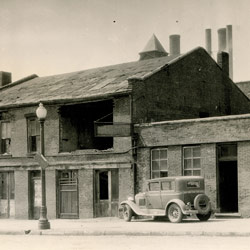Groundbreaking ceremonies on September 7, 2010, initiated building on the block now known as Museum Square. By late 2012, the opening of the Peoria Riverfront Museum and Caterpillar Visitors’ Center will culminate nearly 15 years of planning, study, fundraising and anticipation.
The site has a long history, including 12,000 years of Native American settlement in the Illinois Valley. The French, who had come through beginning in 1673, were burned out of their nearby settlement in 1812, and their land appropriated for Fort Clark and Peoria’s first American settlers in 1813. William S. Hamilton, son of George Washington’s Treasury Secretary Alexander Hamilton, surveyed the disputed French claims in 1823, and a few years later, laid out and named Peoria’s original grid of broad streets that include the block.
A costumed “George Washington” christened the area bounded by Water, Main, Washington and Liberty streets as “Washington Square,” when Sears, Roebuck & Company opened its store on August 5, 1965. A one-story colonial-style building on the southeast corner of Washington and Main housed Bishops Cafeteria, a popular eatery once located further up Main. Until recently, the block carried the Sears name.
Parking lots already covered large sections of the area in 1963, when the Peoria Development Corporation, a group of businesses headed by banker David Connor, announced plans to redevelop the area. Some 34 buildings remained to be razed and 24 businesses closed or relocated. Among them were warehouses, a gas station, a fruit and vegetable market, numerous printers, engravers and a book bindery, as well as companies that endure today, including Connor Company, Nailon Corp., Newman & Ullman, and Behm & Hagemann. The latter’s three-story brick building on Liberty was the second largest to come down after demolition began on December 4, 1963.
The printing companies remained a legacy from the times when the alley below Washington between Main and Liberty was known as Printer’s Alley. The Peoria Fire Department recorded the first official fatal fire in the area in 1850, which claimed the lives of two newspapermen. It occurred in a three-story structure that housed the offices of the Daily Champion and the Weekly Register, along with Herron’s Drug Store and Decker’s Boarding House.
Because of its propensity for flooding, Water Street was never as prosperous as those locations on higher ground. But its convenience to canoe and, later, steamboat landings, and then to rail traffic provided opportunities for enterprise addressing the needs and wants of travelers and commerce. Hotels, boarding houses, saloons, cigar stores, liquor wholesalers, seed companies, and grocery and hardware suppliers developed.
 From police and fire records, we learn of other early activities on Water Street, including the legendary Wyatt Earp’s arrest in a house of ill fame and a vigorous 1864 hosing of Biddie McNally’s “notorious den”—an action denounced by Mayor Jacob Gale as an “outrageous attack upon a poor defenseless woman.”
From police and fire records, we learn of other early activities on Water Street, including the legendary Wyatt Earp’s arrest in a house of ill fame and a vigorous 1864 hosing of Biddie McNally’s “notorious den”—an action denounced by Mayor Jacob Gale as an “outrageous attack upon a poor defenseless woman.”
Wooden construction, the proximity to spark-spewing locomotives and the use of fire for heating, cooking and illumination led to many fires in those blocks and the destruction of such businesses as foundries, a plow factory, a hides and tallow works, a bottling company, clothing and dry goods stores, and a tin, copper, sheet iron and stove shop. A December 15, 1862 fire at the southeast corner of Washington and Main included a drug store and the studios of H. Cole, a prominent daguerreotypist who photographed Abraham Lincoln, as well as many of the local fellows who fought in the Civil War.
Changing needs meant the end of stables and carriage builders. Prohibition brought the transition of saloons to “soft drink parlors” and the rise of off-the-record “speakeasies.” The decline of river commerce and the relocation of barge terminals further from downtown, the decreasing importance of rail traffic and associated warehouses, and the need for more automobile parking created a shift downtown.
By 1965, the Peoria Development Corporation secured the entire site, constructed the buildings and signed Sears to a 30-year-lease. The project formed a key part of major development downtown. But by the time the lease expired in 1995, Sears was yielding to active wooing, and it relocated to Northwoods Mall in 1998. That year, the Peoria Development Corporation sold the property to Peoria’s City Council for less than $1 million, “donating” $1 million of the actual price of $2.1 million back to the city. The property was used for police training and leased parking until demolition began on October 10, 2005.
Arrangements for the museum and visitor center were finalized in 2010. In preparation for the newest development, Water Street has already been elevated and the railroad tracks effectively fenced and landscaped to discourage unsafe crossing. A sewer line which remained beneath the Sears site, a remnant of the time when Fulton Street ran to Water Street, has been rerouted. The concrete that formed the basis for three levels of parking for the former Sears Roebuck and Company store and the cafeteria building has been removed.
Construction bids have been solicited, reviewed and approved, and designs for the interiors of the museum and visitors’ center are underway. The next chapter in the block’s ongoing history has begun. iBi


